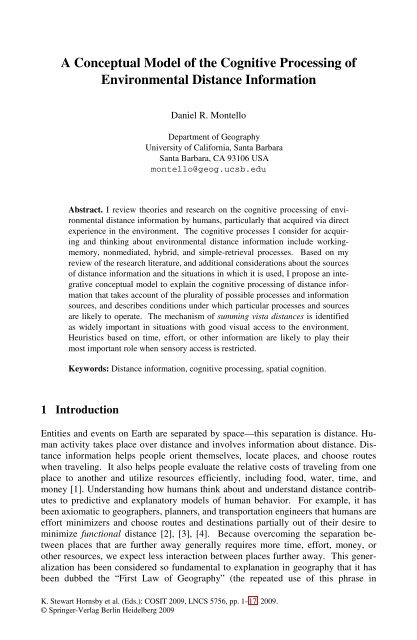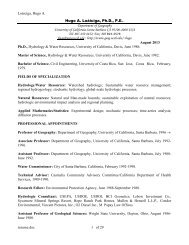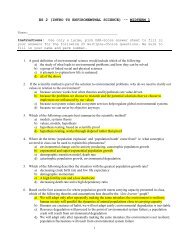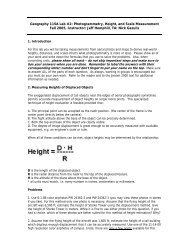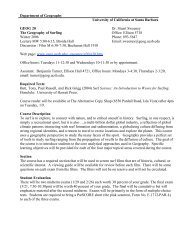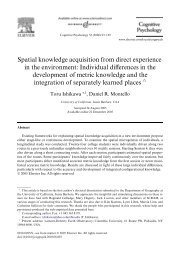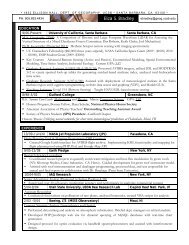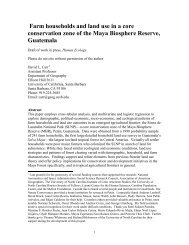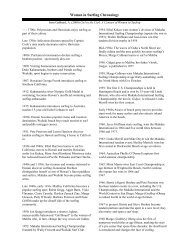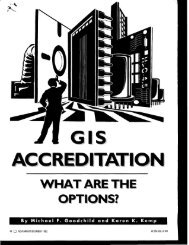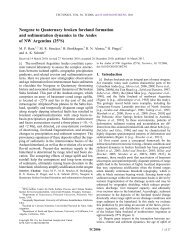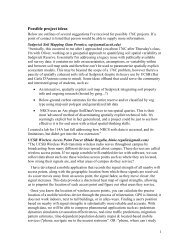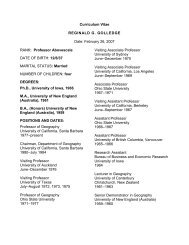A Conceptual Model of the Cognitive Processing of Environmental ...
A Conceptual Model of the Cognitive Processing of Environmental ...
A Conceptual Model of the Cognitive Processing of Environmental ...
You also want an ePaper? Increase the reach of your titles
YUMPU automatically turns print PDFs into web optimized ePapers that Google loves.
A <strong>Conceptual</strong> <strong>Model</strong> <strong>of</strong> <strong>the</strong> <strong>Cognitive</strong> <strong>Processing</strong> <strong>of</strong><br />
<strong>Environmental</strong> Distance Information<br />
Daniel R. Montello<br />
Department <strong>of</strong> Geography<br />
University <strong>of</strong> California, Santa Barbara<br />
Santa Barbara, CA 93106 USA<br />
montello@geog.ucsb.edu<br />
Abstract. I review <strong>the</strong>ories and research on <strong>the</strong> cognitive processing <strong>of</strong> environmental<br />
distance information by humans, particularly that acquired via direct<br />
experience in <strong>the</strong> environment. The cognitive processes I consider for acquiring<br />
and thinking about environmental distance information include workingmemory,<br />
nonmediated, hybrid, and simple-retrieval processes. Based on my<br />
review <strong>of</strong> <strong>the</strong> research literature, and additional considerations about <strong>the</strong> sources<br />
<strong>of</strong> distance information and <strong>the</strong> situations in which it is used, I propose an integrative<br />
conceptual model to explain <strong>the</strong> cognitive processing <strong>of</strong> distance information<br />
that takes account <strong>of</strong> <strong>the</strong> plurality <strong>of</strong> possible processes and information<br />
sources, and describes conditions under which particular processes and sources<br />
are likely to operate. The mechanism <strong>of</strong> summing vista distances is identified<br />
as widely important in situations with good visual access to <strong>the</strong> environment.<br />
Heuristics based on time, effort, or o<strong>the</strong>r information are likely to play <strong>the</strong>ir<br />
most important role when sensory access is restricted.<br />
Keywords: Distance information, cognitive processing, spatial cognition.<br />
1 Introduction<br />
Entities and events on Earth are separated by space—this separation is distance. Human<br />
activity takes place over distance and involves information about distance. Distance<br />
information helps people orient <strong>the</strong>mselves, locate places, and choose routes<br />
when traveling. It also helps people evaluate <strong>the</strong> relative costs <strong>of</strong> traveling from one<br />
place to ano<strong>the</strong>r and utilize resources efficiently, including food, water, time, and<br />
money [1]. Understanding how humans think about and understand distance contributes<br />
to predictive and explanatory models <strong>of</strong> human behavior. For example, it has<br />
been axiomatic to geographers, planners, and transportation engineers that humans are<br />
effort minimizers and choose routes and destinations partially out <strong>of</strong> <strong>the</strong>ir desire to<br />
minimize functional distance [2], [3], [4]. Because overcoming <strong>the</strong> separation between<br />
places that are fur<strong>the</strong>r away generally requires more time, effort, money, or<br />
o<strong>the</strong>r resources, we expect less interaction between places fur<strong>the</strong>r away. This generalization<br />
has been considered so fundamental to explanation in geography that it has<br />
been dubbed <strong>the</strong> “First Law <strong>of</strong> Geography” (<strong>the</strong> repeated use <strong>of</strong> this phrase in<br />
K. Stewart Hornsby et al. (Eds.): COSIT 2009, LNCS 5756, pp. 1–17, 2009.<br />
© Springer-Verlag Berlin Heidelberg 2009
2 D.R. Montello<br />
textbooks and research literature suggests it is taken quite seriously, e.g., see <strong>the</strong> Forum<br />
[5] in <strong>the</strong> journal Annals <strong>of</strong> <strong>the</strong> Association <strong>of</strong> American Geographers).<br />
Behavioral geographers and o<strong>the</strong>rs proposed some time ago that is was not<br />
objective or actual distance that alone accounted for human activity. Instead, <strong>the</strong>y<br />
proposed that models <strong>of</strong> human spatial activity could be improved by considering<br />
subjective distance—what people know or believe about distance [4], [6], [7], [8].<br />
For example, when I choose to visit one store ra<strong>the</strong>r than ano<strong>the</strong>r because it is closer,<br />
I base this choice on my belief that <strong>the</strong> one is closer, whatever <strong>the</strong> true distance is.<br />
Thus it is evident that understanding human perception and cognition <strong>of</strong> distances is<br />
necessary for understanding human spatial activity and interaction between places.<br />
Although much navigation and spatial planning can occur without precise metric<br />
information about distances, or even without distance information at all, I have argued<br />
elsewhere that some quantitative information about distances is required to explain<br />
human behavior in <strong>the</strong> environment, for both conceptual and empirical reasons [1],<br />
[9]. Nei<strong>the</strong>r information about <strong>the</strong> sequences <strong>of</strong> landmarks nor information about<br />
travel times are sufficient by <strong>the</strong>mselves (<strong>of</strong> course, travel time could provide <strong>the</strong> basis<br />
for metric information about <strong>the</strong> separations between places). <strong>Conceptual</strong>ly, some<br />
quantitative distance information was needed by our evolutionary ancestors in order<br />
to navigate creatively; such creativity includes making shortcuts and detours in an<br />
efficient manner. Inferring <strong>the</strong> direction straight back to home after several hours or<br />
days <strong>of</strong> circuitous travel requires distance information, not just information about<br />
landmark sequences or travel times. Such creativity clearly is still valuable in present<br />
times for many <strong>of</strong> us, in many situations. Empirically, systematic observation that<br />
people can make metrically accurate distance estimates, and can perform shortcut and<br />
detour tasks with some accuracy, supports <strong>the</strong> psychological reality <strong>of</strong> distance<br />
knowledge [1], [10], [11].<br />
Recognizing its importance and pervasive role in human activity, this paper provides<br />
a comprehensive and interdisciplinary review <strong>of</strong> <strong>the</strong> cognitive processing <strong>of</strong><br />
distance information by humans. It also proposes a conceptual model <strong>of</strong> <strong>the</strong> perception<br />
and cognition <strong>of</strong> environmental distance. As I stated in [1], a complete model <strong>of</strong><br />
environmental distance knowledge and estimation provides answers to four questions:<br />
1. What is perceived and stored during travel that provides a basis for distance<br />
knowledge?<br />
2. What is retrieved from long-term memory (LTM) when distance information<br />
is used (e.g., when travel planning is carried out) that determines<br />
or influences distance knowledge?<br />
3. What inferential or computational processes, if any, are applied to information<br />
retrieved from LTM to produce usable distance knowledge?<br />
4. How does <strong>the</strong> technique used to measure distance knowledge influence<br />
estimates <strong>of</strong> distance?<br />
Distance knowledge and its expression as measured data in cognitive research result<br />
from processes and information sources addressed by <strong>the</strong> first three questions, in addition<br />
to aspects specific to <strong>the</strong> measurement technique used to collect estimates, addressed<br />
by <strong>the</strong> fourth question. In [12], I reviewed techniques for measuring distance<br />
knowledge, comparing techniques based on psychophysical ratio, interval, and ordinal<br />
scaling; mapping; reproduction (i.e., retraveling); and route choice. Of course, researchers<br />
have uncovered significant new insights about distance estimation since my
A <strong>Conceptual</strong> <strong>Model</strong> <strong>of</strong> <strong>the</strong> <strong>Cognitive</strong> <strong>Processing</strong> 3<br />
review. One <strong>of</strong> <strong>the</strong> most significant insights about estimating distance (and o<strong>the</strong>r spatial<br />
properties such as slope) concerns an apparent dissociation between spatial<br />
knowledge expressed via direct motoric action, such as retraveling a route as part <strong>of</strong><br />
distance reproduction, and knowledge expressed via indirect, symbolic techniques,<br />
such as verbal estimation in familiar units (a common technique I grouped with ratio<br />
scaling methods in [12]), [13], [14].<br />
In [1], I focused on <strong>the</strong> sources <strong>of</strong> information for distance knowledge, addressing<br />
primarily <strong>the</strong> first two questions above. To <strong>the</strong> extent that distance information is<br />
acquired via travel through <strong>the</strong> environment, knowledge <strong>of</strong> distances must ultimately<br />
be based on some kind <strong>of</strong> environmental information, such as <strong>the</strong> number <strong>of</strong> landmarks<br />
encountered, or proprioceptive information, such as <strong>the</strong> bodily sense <strong>of</strong> travel<br />
speed. I organized <strong>the</strong>se sources <strong>of</strong> information into three classes: (1) number <strong>of</strong> environmental<br />
features, typically but not exclusively visually perceived, (2) travel time,<br />
and (3) travel effort or expended energy. I concluded that environmental features<br />
enjoys <strong>the</strong> most empirical support as a source <strong>of</strong> distance information, although not all<br />
types <strong>of</strong> features are equally likely to influence beliefs about distance. Features noticed<br />
by travelers and used by <strong>the</strong>m to organize traveled routes into segments will<br />
most impact distance knowledge, e.g., [15], [16]. Two explicit variants <strong>of</strong> features as<br />
a source <strong>of</strong> distance information are step counting and environmental pattern counting<br />
(e.g., counting blocks).<br />
Travel time is logically compelling as a source <strong>of</strong> distance information, especially<br />
in situations <strong>of</strong> restricted access to o<strong>the</strong>r kinds <strong>of</strong> information, but it has not been convincingly<br />
demonstrated in much research and is <strong>of</strong>ten misconceptualized ins<strong>of</strong>ar as<br />
researchers have failed to consider <strong>the</strong> role <strong>of</strong> movement speed. Also, travel effort<br />
enjoys very little empirical support but may still function when it provides <strong>the</strong> only<br />
possible basis for judging distances. Since 1997, new research has been reported on<br />
<strong>the</strong> perception <strong>of</strong> travel speed [17] and its role in distance cognition [18], [19]. Also,<br />
research has been reported on <strong>the</strong> role <strong>of</strong> effort that suggests it can influence <strong>the</strong> perception<br />
<strong>of</strong> vista distances when people anticipate <strong>the</strong>y will need to climb a sloped<br />
pathway [20], [21]. None<strong>the</strong>less, showing that experienced effort influences estimates<br />
<strong>of</strong> environmental distances that have actually been traveled remains an elusive<br />
phenomenon.<br />
In this paper, I address <strong>the</strong> remaining question relevant to a complete model <strong>of</strong> directly<br />
experienced environmental distance knowledge and estimation, Question 3.<br />
This question asks what inferential or computational processes, if any, are brought to<br />
bear on information retrieved from LTM so as to produce usable distance information.<br />
To address this question, I describe alternative processes for how humans acquire,<br />
store, and retrieve directly experienced distance information. I summarize <strong>the</strong>se processes<br />
in <strong>the</strong> form <strong>of</strong> a conceptual model that comprehensively presents alternative<br />
ways people process distance information and <strong>the</strong> conditions likely to lead to one alternative<br />
or ano<strong>the</strong>r.<br />
My review and model are organized around a <strong>the</strong>oretical framework that proposes<br />
<strong>the</strong>re are alternative processes accounting for distance knowledge in different situations<br />
and multiple, partially redundant information sources that differentially provide<br />
information about distances as a function <strong>of</strong> availability and spatial scale. A few<br />
models <strong>of</strong> environmental distance processing have been proposed in <strong>the</strong> literature.<br />
The model I present below modifies and extends models proposed some time ago by
4 D.R. Montello<br />
Briggs [22], Downs and Stea [23], and Thorndyke and Hayes-Roth [24]. These proposals<br />
contributed to a comprehensive <strong>the</strong>ory <strong>of</strong> environmental distance information<br />
but have not been significantly updated in over two decades. Fur<strong>the</strong>rmore, <strong>the</strong>se older<br />
models did not fully express <strong>the</strong> plurality <strong>of</strong> plausible distance processes, <strong>the</strong> idea that<br />
a single process can operate on different information sources, nor <strong>the</strong> idea that a single<br />
source might be processed in different ways. Thus, <strong>the</strong> evidence that researchers<br />
have put forth for some aspect <strong>of</strong> distance cognition is <strong>of</strong>ten consistent with multiple<br />
specific explanations, making its interpretation ambiguous. What’s more, <strong>the</strong>re are<br />
partially redundant cognitive systems for processing and estimating traveled distances.<br />
More than one system can operate within and between research studies, and<br />
even within individual people on different occasions.<br />
2 <strong>Environmental</strong> Distance, Directly Experienced<br />
As in my earlier review <strong>of</strong> sources <strong>of</strong> distance information [1], I am concerned in this<br />
manuscript with information about distances in environmental spaces [25]. These are<br />
physical spaces (typically Earth-surface spaces) that are much larger than <strong>the</strong> human<br />
body and surround it, requiring considerable locomotion for <strong>the</strong>ir direct, sensorimotor<br />
apprehension. Examples <strong>of</strong> environmental spaces include buildings, campuses, parks,<br />
and urban neighborhoods (it is largely an open research question as to how well spatially<br />
talented people can directly apprehend <strong>the</strong> spaces <strong>of</strong> large cities and beyond).<br />
Their direct apprehension is thus thought to require integrating information over significant<br />
time periods, on <strong>the</strong> order <strong>of</strong> minutes, hours, days, or more. However, unlike<br />
gigantic spaces (termed geographic spaces in [25]), environmental spaces are small<br />
enough to be apprehended through direct travel experience and do not require maps,<br />
even though maps may well facilitate <strong>the</strong>ir apprehension. Many studies, especially in<br />
geography, concern distance information acquired indirectly (symbolically) in naturalistic<br />
settings, at least in part, e.g., [26], [27], [28], [29], [30]. The results <strong>of</strong> <strong>the</strong>ses<br />
studies are somewhat ambiguous with respect to how travel-based environmental distance<br />
information is processed.<br />
There is a great deal <strong>of</strong> research on <strong>the</strong> perception <strong>of</strong> distance in vista spaces, visually<br />
perceptible from a single vantage point [31], [32], [33], [34], [35]. This research<br />
has <strong>of</strong>ten been concerned with evaluating <strong>the</strong> fit <strong>of</strong> Stevens’s Power Law to vista distance<br />
estimates under various conditions. The Power Law states that subjective distance<br />
equals physical distance raised to some exponent and multiplied by a scaling<br />
constant. Most interest has been in <strong>the</strong> size <strong>of</strong> <strong>the</strong> exponent, which has usually been<br />
found to be near 1.0, a linear function (exponents < 1.0, a decelerating function, have<br />
been reported more <strong>of</strong>ten than exponents > 1.0, but both have been found). This work<br />
is relevant to our concern with environmental distance for at least two reasons. First,<br />
psychophysical distance scaling has been methodologically important in <strong>the</strong> study <strong>of</strong><br />
environmental distance information, as I reviewed above. Second, I propose below<br />
that perceived distances in vista spaces provide an important source <strong>of</strong> information for<br />
environmental distance knowledge.<br />
However, it is important to distinguish between “visual” and “spatial.” Spatial information<br />
expresses properties like size, location, movement, and connectivity along<br />
one or more dimensions <strong>of</strong> space. Most visually-acquired information has a spatial
6 D.R. Montello<br />
simple-retrieval processes. Working-memory processes are those in which relatively<br />
effortful (i.e., demanding on limited resources <strong>of</strong> conscious thought) inferential or<br />
computational processes are brought to bear on cognitive representations constructed<br />
in working memory (WM) when distance information is used; information about distance<br />
per se is not explicitly stored in memory during locomotion. Nonmediated<br />
processes are those in which distance information is encoded and stored directly during<br />
locomotion, without <strong>the</strong> need for much explicit inference or computation when<br />
distance information is used. Hybrid processes combine <strong>the</strong> two: Information about<br />
<strong>the</strong> distances <strong>of</strong> single segments is directly stored and retrieved, but effortful WM<br />
processes are required to combine <strong>the</strong> segments into knowledge <strong>of</strong> multi-segment<br />
distances. Finally, simple retrieval occurs when distance information is well learned<br />
and can be retrieved from long-term memory (LTM) as an explicit belief without any<br />
inferential processes. For example, one may have stored in LTM that it is about 240<br />
miles from Fargo to Minneapolis, and can directly retrieve (i.e., recall or recognize)<br />
that without making an inference or computation. In some cases, a simple-retrieval<br />
process results from <strong>the</strong> explicit storage <strong>of</strong> distance information originally derived via<br />
o<strong>the</strong>r processes. Explicit estimates <strong>of</strong> distance would especially be available for simple<br />
retrieval when a person has previously made an explicit estimate based on o<strong>the</strong>r<br />
processes and <strong>the</strong>n externalized it in words or numbers. In many o<strong>the</strong>r cases, it<br />
probably results in <strong>the</strong> first place from knowledge acquired indirectly via maps or<br />
language.<br />
<strong>Model</strong>s <strong>of</strong> spatial working-memory processes typically describe <strong>the</strong> WM representations<br />
as analogue or imagistic, although WM representations may be numeric,<br />
verbal, and so on. Two types <strong>of</strong> analogue representations may be considered. Travel<br />
re-creation refers to a process in which a temporally-ordered sequence <strong>of</strong> environmental<br />
images is generated that essentially re-creates a sequence <strong>of</strong> percepts experienced<br />
while moving through <strong>the</strong> environment. Survey-map scanning refers to a<br />
process in which a unitary, map-like spatial image is generated that represents part <strong>of</strong><br />
an environment more abstractly, essentially from a vertical or oblique perspective.<br />
Foley and Cohen [50] refer to travel re-creation as scenographic encoding and survey-map<br />
scanning as abstract encoding. The distinction between travel re-creation<br />
and survey-map scanning is similar to <strong>the</strong> distinction by Thorndyke and Hayes-Roth<br />
[24] between environmental representations learned via navigation and those learned<br />
via maps. However, <strong>the</strong> distinction I make here refers to <strong>the</strong> nature <strong>of</strong> <strong>the</strong> representation<br />
and not to its manner <strong>of</strong> acquisition. Although <strong>the</strong> nature <strong>of</strong> one’s learning experience<br />
almost certainly influences <strong>the</strong> nature <strong>of</strong> one’s environmental representations<br />
(as Thorndyke and Hayes-Roth proposed and empirically supported), <strong>the</strong> extent to<br />
which this is true is still an open question (see review and discussion in [51]).<br />
The generation and use <strong>of</strong> one or <strong>the</strong> o<strong>the</strong>r type <strong>of</strong> analogue representation might<br />
be empirically distinguishable in several ways. Thorndyke and Hayes-Roth [24] conjectured<br />
that patterns <strong>of</strong> performance on certain distance and angular estimation tasks<br />
would differ for <strong>the</strong> two. For instance, straight-line distance estimates should be less<br />
accurate than distance estimates along a route in <strong>the</strong> case <strong>of</strong> travel re-creation; <strong>the</strong><br />
opposite should be true in <strong>the</strong> case <strong>of</strong> survey-map scanning. Siegel et al. [52]<br />
proposed that when a route is represented and accessed as a linear sequence (travel recreation),<br />
distance estimates in opposite directions would differ in accuracy as a function<br />
<strong>of</strong> <strong>the</strong> direction in which <strong>the</strong> route was learned. Palij [53] suggested that what he
A <strong>Conceptual</strong> <strong>Model</strong> <strong>of</strong> <strong>the</strong> <strong>Cognitive</strong> <strong>Processing</strong> 7<br />
called imagined terrains (re-created travels) should be readily accessible in any<br />
alignment that is necessary for <strong>the</strong> task at hand. <strong>Cognitive</strong> maps (Palij’s term for survey<br />
maps) should require extra time and effort to access in alignments that differ from<br />
a canonical alignment, such as <strong>the</strong> alignment in which one has viewed <strong>the</strong> layout.<br />
Such alignment effects are robust and well established when involving in-situ navigation<br />
maps, e.g., [54], but somewhat inconsistent when involving mental representations<br />
acquired from direct experience, e.g., [55]. Ei<strong>the</strong>r way, however, it is likely that<br />
a re-created travel would also be less accessible in non-canonical alignments, such as<br />
those not based on <strong>the</strong> forward direction <strong>of</strong> travel.<br />
What types <strong>of</strong> effortful processes might be applied to <strong>the</strong> representations generated<br />
in working memory as part <strong>of</strong> WM (and hybrid) processes? Thorndyke and Hayes-<br />
Roth [24] provided detailed possibilities. In <strong>the</strong> case <strong>of</strong> information acquired via<br />
navigation (travel re-creation), <strong>the</strong>y proposed that individual straight-line segments<br />
are estimated and summed in WM to arrive at an estimate <strong>of</strong> total route distance (<strong>the</strong>y<br />
did not specify how individual segments are estimated). If straight-line estimates<br />
were required between points not in <strong>the</strong> same segment, angular estimation coupled<br />
with some “mental trigonometry” would also be required. In <strong>the</strong> case <strong>of</strong> information<br />
acquired via maps (survey-map scanning), straight-line distance between any two<br />
points is estimated from scanning <strong>the</strong> imaged map, as in image scanning [56]. If route<br />
distance is required, individual segments would have to be scanned and <strong>the</strong> resulting<br />
distances summed. Whatever <strong>the</strong> case, <strong>the</strong> existence <strong>of</strong> such WM processes is suggested<br />
by introspection, logical analysis <strong>of</strong> task demands, and scanning-time data,<br />
e.g., [57]. Fur<strong>the</strong>rmore, research shows that <strong>the</strong> context created when representations<br />
are constructed in WM during estimation can affect <strong>the</strong> magnitude <strong>of</strong> estimated distances<br />
considerably [58]. Among o<strong>the</strong>r things, it can lead to patterns <strong>of</strong> asymmetries<br />
wherein <strong>the</strong> distance from A to B is estimated to be different than <strong>the</strong> distance from B<br />
to A [59], [60].<br />
Hirtle and Mascolo [61] suggested additional WM processes. They conducted a<br />
protocol analysis in which subjects thought aloud while estimating distances between<br />
US cities. Although such information would be strongly influenced by maps and<br />
o<strong>the</strong>r symbolic sources, <strong>the</strong>ir work richly suggests many possible processes that could<br />
be used to generate estimates from directly-acquired knowledge. Hirtle and Mascolo<br />
identified as many as 20 strategies or heuristics claimed to have been used by subjects,<br />
including simple retrieval, imagery, translation from retrieval <strong>of</strong> time, comparisons<br />
to o<strong>the</strong>r distances, and various forms <strong>of</strong> ma<strong>the</strong>matical manipulation <strong>of</strong> segments<br />
(e.g., segment addition). They also found that <strong>the</strong> use <strong>of</strong> compound strategies (as in a<br />
hybrid process) was more likely with longer distances and less familiar places. That<br />
is, various indirect heuristics are more likely to be used when people do not have direct<br />
travel experience with a particular route.<br />
For <strong>the</strong> most part, <strong>the</strong> WM processes described by Thorndyke and Hayes-Roth, and<br />
by Hirtle and Mascolo, do not explain what information is used to estimate <strong>the</strong> lengths<br />
<strong>of</strong> individual segments, nor how it is processed. But it is clear that processes used to<br />
access information with WM representations would be demanding <strong>of</strong> attentional<br />
resources—effortful and accessible to consciousness. With both WM and hybrid<br />
processes, however, repeated retrieval and inference with some particular distance<br />
information could eventually result in its processing by simple retrieval.
8 D.R. Montello<br />
The class <strong>of</strong> nonmediated processes contrasts sharply with <strong>the</strong> WM and hybrid<br />
processes. Nonmediated processes do not rely on effortful inferences operating on<br />
WM representations. Instead, nonmediated processes lead to direct storage <strong>of</strong> distance<br />
information. Alternatively, information about time or effort might be acquired<br />
via a nonmediated process <strong>of</strong> some kind. Estimates <strong>of</strong> distance could <strong>the</strong>n be derived<br />
from simple computational processes translating time or effort into distance.<br />
Nonmediated processes essentially <strong>of</strong>fer an alternative to <strong>the</strong> idea that <strong>the</strong> generation<br />
and manipulation <strong>of</strong> images in WM is necessary for generating environmental<br />
distance knowledge. In <strong>the</strong> general context <strong>of</strong> imagery and psychological processing,<br />
Gibson [62] wrote that:<br />
No image can be scrutinized...[a]n imaginary object can undergo an<br />
imaginary [italics in original] scrutiny...but you are not going to discover<br />
a new and surprising feature <strong>of</strong> <strong>the</strong> object this way. For it is <strong>the</strong><br />
very features <strong>of</strong> <strong>the</strong> object that your perceptual system has already<br />
picked up that constitute your ability to visualize it. (p. 257)<br />
This quote suggests that it would be necessary to “know” how far it is from A to B in<br />
order to construct an accurate image <strong>of</strong> it in WM—that “new” information cannot be<br />
extracted from images. If so, <strong>the</strong> imagery experienced and reported during distance<br />
estimation would be epiphenomenal. Pylyshyn [63], whose <strong>the</strong>oretical orientation<br />
o<strong>the</strong>rwise differs radically from Gibson’s, <strong>of</strong>fers a related criticism <strong>of</strong> <strong>the</strong> functional<br />
scanning <strong>of</strong> images based on a <strong>the</strong>ory <strong>of</strong> tacit information.<br />
Gibson did not specifically address environmental distance information. However,<br />
his framework does suggest one way that nonmediated processes might work to generate<br />
distance knowledge. The visual system is attuned to pick up dynamic changes in<br />
<strong>the</strong> optic array, called optic flow, that specify movement <strong>of</strong> oneself through <strong>the</strong> environment<br />
(visual kines<strong>the</strong>sis). When coupled with perceptions <strong>of</strong> environmental layout,<br />
visual kines<strong>the</strong>sis might lead to information about traveled distance without <strong>the</strong><br />
necessity <strong>of</strong> constructing analogue memory representations. Rieser and his colleagues<br />
[48] developed this approach in <strong>the</strong>ir <strong>the</strong>ory <strong>of</strong> visual-proprioceptive coupling. According<br />
to this, information about distance gained from optic flow is used to calibrate<br />
proprioceptive systems. These proprioceptive systems also produce distance information<br />
during locomotion, allowing acquisition <strong>of</strong> environmental distance information<br />
by blind or blindfolded subjects (also see [64]). An interesting way in which Rieser<br />
and his colleagues demonstrated calibration is to show that reproductions <strong>of</strong> walked<br />
distances can be altered by recalibrating <strong>the</strong> visual-proprioceptive coupling when research<br />
subjects are required to walk on treadmills pulled around on trailers.<br />
Vestibular and kines<strong>the</strong>tic sensing would likely play an important role in a nonmediated<br />
process for generating distance information [65], [66], although <strong>the</strong>re are apparently<br />
situations where <strong>the</strong>se proprioceptive body senses play a restricted role, such as<br />
when riding in an automobile [67]. The acceleration picked up by <strong>the</strong> vestibules and <strong>the</strong><br />
semicircular canals is integrated over time by <strong>the</strong> central nervous system, again without<br />
<strong>the</strong> need for effortful scanning or manipulation <strong>of</strong> images. Information about traveled<br />
distance is thus available as a function <strong>of</strong> relatively automatic perceptual updating processes<br />
that have evolved to allow humans and o<strong>the</strong>r organisms to stay oriented in <strong>the</strong><br />
environment without great demands on attentional resources [68], [69].
A <strong>Conceptual</strong> <strong>Model</strong> <strong>of</strong> <strong>the</strong> <strong>Cognitive</strong> <strong>Processing</strong> 9<br />
3.1 Processes: Summary and Discussion<br />
I propose four classes <strong>of</strong> mechanisms by which humans process information about<br />
environmental distances: working-memory, nonmediated, hybrid, and simple-retrieval<br />
processes. These are primarily distinguished from one ano<strong>the</strong>r on <strong>the</strong> basis <strong>of</strong> <strong>the</strong> extensiveness<br />
<strong>of</strong> <strong>the</strong> computations or inferences people carry out in WM in order to use distance<br />
information. According to a working-memory process, effortful manipulations<br />
are carried out on explicit representations constructed in WM. These representations are<br />
frequently analogue representations (i.e., images <strong>of</strong> path extensions) but need not be.<br />
Two major types <strong>of</strong> relevant analogue representations can be identified—travel recreation<br />
and survey-map scanning; I considered ways <strong>the</strong> two might be empirically distinguished.<br />
I also detailed several ways that WM representations could be manipulated<br />
in order to infer explicit estimates <strong>of</strong> distance (e.g., image scanning).<br />
In stark contrast, a nonmediated process does not require <strong>the</strong> construction or manipulation<br />
<strong>of</strong> WM representations, analogue or o<strong>the</strong>rwise. Instead, distance information<br />
is acquired and stored during locomotion as a result <strong>of</strong> implicit computational<br />
processes that are outside <strong>of</strong> <strong>the</strong> conscious awareness <strong>of</strong> <strong>the</strong> locomoting person. Hybrid<br />
processes combine WM and nonmediated processes. The lengths <strong>of</strong> single segments<br />
are stored and retrieved by a nonmediated process; information about <strong>the</strong> single<br />
segments is manipulated in WM in order to arrive at information about multi-segment<br />
distances. Finally, simple retrieval occurs when an explicit distance judgment can be<br />
retrieved from LTM without any inferential or computational processes. This would<br />
take place with directly experienced extents when an estimate <strong>of</strong> <strong>the</strong> length <strong>of</strong> some<br />
particular route has become well learned and stored explicitly in LTM.<br />
Although only one <strong>of</strong> <strong>the</strong>se processes can operate during a particular occasion in<br />
which distance information is used, it is not necessary to conclude that only one <strong>of</strong><br />
<strong>the</strong>m generally characterizes <strong>the</strong> processing <strong>of</strong> distance information. On <strong>the</strong> contrary,<br />
it is likely that all four processes are used in different situations. What determines<br />
which process operates? My review and description <strong>of</strong> <strong>the</strong> four classes suggests that<br />
one <strong>of</strong> <strong>the</strong> major factors involved is whe<strong>the</strong>r an explicit judgment <strong>of</strong> distance is required<br />
in a given situation, and whe<strong>the</strong>r that estimate is already stored as such in<br />
LTM. I turn now to a model that proposes some specific conditions that influence<br />
when such explicitness is likely to be necessary.<br />
4 A Comprehensive <strong>Conceptual</strong> <strong>Model</strong> <strong>of</strong> <strong>the</strong> <strong>Cognitive</strong><br />
<strong>Processing</strong> <strong>of</strong> Directly-Acquired <strong>Environmental</strong> Distance<br />
Information<br />
Ideas about processes can be combined with ideas about sources <strong>of</strong> information in<br />
order to formulate a comprehensive conceptual model <strong>of</strong> <strong>the</strong> perception and cognition<br />
<strong>of</strong> environmental distance. I propose a model that addresses three questions posed in<br />
<strong>the</strong> introduction: (1) What is perceived and stored during travel that provides a basis<br />
for distance knowledge?, (2) what is retrieved from LTM when distance information<br />
is used?, and (3) what inferential or computational processes, if any, are brought to<br />
bear on <strong>the</strong> retrieved information so as to produce usable distance knowledge? (The<br />
model does not specifically address <strong>the</strong> influence <strong>of</strong> <strong>the</strong> techniques researchers use to
10 D.R. Montello<br />
<br />
Task requires<br />
explicit knowledge?<br />
NO<br />
Visual or proprioceptive<br />
movement information<br />
available?<br />
NO<br />
Time/effort<br />
heuristics<br />
YES<br />
YES<br />
Updating via<br />
dead reckoning<br />
Distance estimate<br />
already in LTM?<br />
YES<br />
Simple<br />
retrieval<br />
NO<br />
Person has visual<br />
access to vistas?<br />
NO<br />
Prospective<br />
estimation?<br />
NO<br />
Time/effort<br />
heuristics<br />
YES<br />
YES<br />
Summing vista<br />
distances<br />
Explicit step<br />
counting<br />
Larger-scale<br />
extents?<br />
Prospective<br />
estimation?<br />
YES<br />
YES<br />
Time/effort<br />
heuristics<br />
Explicit step/pattern<br />
counting<br />
Fig. 1. Proposed model <strong>of</strong> <strong>the</strong> multiple processes and information sources for perceiving and<br />
cognizing environmental distance. Diamonds are decision nodes, rectangles are end states. All<br />
end states make knowledge <strong>of</strong> distance available in <strong>the</strong> form needed for <strong>the</strong> task being performed.
A <strong>Conceptual</strong> <strong>Model</strong> <strong>of</strong> <strong>the</strong> <strong>Cognitive</strong> <strong>Processing</strong> 11<br />
measure distance knowledge.) Figure 1 depicts <strong>the</strong> model. It is designed to accommodate<br />
<strong>the</strong> availability <strong>of</strong> alternative processes and multiple, partially redundant information<br />
sources. It does this by referring to <strong>the</strong> demands <strong>of</strong> <strong>the</strong> particular task, <strong>the</strong><br />
availability <strong>of</strong> particular information sources, <strong>the</strong> degree <strong>of</strong> familiarity with <strong>the</strong> route<br />
in question, and its spatio-temporal scale.<br />
At <strong>the</strong> outset, it is clear that information about environmental distance based on direct<br />
travel experience depends on <strong>the</strong> perception or awareness <strong>of</strong> body movement or<br />
change <strong>of</strong> position, whe<strong>the</strong>r valid or not. This perception generally derives from<br />
some combination <strong>of</strong> vision, kines<strong>the</strong>sis, vestibular sensation, audition, and motor<br />
efference—any or all <strong>of</strong> <strong>the</strong>m can contribute in a given situation. As a consequence,<br />
information that does not involve any sense or belief <strong>of</strong> movement, such as a judgment<br />
<strong>of</strong> elapsed time alone, cannot in itself account for distance knowledge.<br />
The model first branches as a function <strong>of</strong> whe<strong>the</strong>r a task requires, or at least tends<br />
to activate, explicit knowledge <strong>of</strong> distance. Some tasks require only implicit information<br />
about distance. Locomotion over familiar routes in <strong>the</strong> environment is an important<br />
example; most <strong>of</strong> us find our way efficiently through <strong>the</strong> environment on a daily<br />
basis without thinking explicitly about our navigational decisions. None<strong>the</strong>less, our<br />
coordinated and efficient travel still requires at least implicit distance knowledge in<br />
many situations. The fact that people sometimes have considerable implicit information<br />
about distances that guides <strong>the</strong>ir behavior in <strong>the</strong> environment does not, however,<br />
ensure that <strong>the</strong>y will be able to externalize that information well using a distance estimation<br />
technique. It is <strong>the</strong>refore possible for subjects to estimate distances explicitly<br />
very poorly but do quite well actually navigating, e.g., [70].<br />
In fact, locomotion along familiar routes sometimes does not require much distance<br />
information at all, as we observed above, although at least implicit knowledge <strong>of</strong><br />
distance is <strong>of</strong>ten involved. A case in point: Some people can infer <strong>the</strong> straight-line<br />
direction from one place to ano<strong>the</strong>r ra<strong>the</strong>r well, with less than 20° <strong>of</strong> error, even though<br />
<strong>the</strong>y have never traveled directly between <strong>the</strong> two places [10]. This ability requiresdistance<br />
information <strong>of</strong> some kind. As long as <strong>the</strong> route is relatively small in scale, so<br />
that explicit information is not required, evidence is strong that people can perform this<br />
task using only <strong>the</strong> implicit information about distance provided by <strong>the</strong> optic flow<br />
and/or proprioceptive feedback occurring during locomotion, e.g., [71]. People may<br />
have little or no awareness <strong>of</strong> <strong>the</strong> operation <strong>of</strong> this process. As long as visual or proprioceptive<br />
information about movement is available, <strong>the</strong>refore, <strong>the</strong> model proposes<br />
that people (strictly speaking, <strong>the</strong>ir cognitive systems) will use a nonmediated process<br />
<strong>of</strong> perceptual updating to “reason” about distances and directions. However, if such<br />
perceptual movement information is not available (e.g., a subway ride at constant<br />
speed), <strong>the</strong>n <strong>the</strong> model again suggests that people will need to rely on heuristics about<br />
<strong>the</strong> time and/or effort required to make <strong>the</strong> trip in order to arrive at knowledge <strong>of</strong> traveled<br />
distance. (As an aside, this situation suggests an important reason why people get<br />
lost much more easily when movement information is restricted: Without implicit spatial<br />
knowledge, <strong>the</strong>ir cognitive system must depend entirely on effortful explicit systems<br />
to maintain orientation, which becomes confused without ongoing attention.)<br />
O<strong>the</strong>r tasks require explicit information about distances, i.e., <strong>the</strong>y require conscious<br />
awareness <strong>of</strong> distance quantities to various levels <strong>of</strong> precision. Notable examples are
12 D.R. Montello<br />
route planning and giving verbal route directions. In addition, I propose that travelers<br />
will require explicit distance information whenever <strong>the</strong>y think about routes <strong>of</strong> large<br />
spatio-temporal scale, no matter what <strong>the</strong> task (e.g., even when navigating in familiar<br />
environments or performing path integration over long distances). Of course, an occasion<br />
requiring explicit distance knowledge that is <strong>of</strong> special interest to behavioral<br />
researchers is when a person participates as a research subject in studies <strong>of</strong> distance<br />
cognition. Nearly all such studies require subjects to make explicit (typically numerical,<br />
graphical, or verbal) estimates <strong>of</strong> distances in <strong>the</strong> environment.<br />
If <strong>the</strong> task does call for explicit distance information, <strong>the</strong> model next asks whe<strong>the</strong>r<br />
an estimate <strong>of</strong> <strong>the</strong> length <strong>of</strong> a given route is already stored in LTM. If it is, <strong>the</strong> process<br />
<strong>of</strong> simple retrieval operates. This might be <strong>the</strong> case when a person is very familiar<br />
with a particular route and has reasoned about its length in <strong>the</strong> past.<br />
The model <strong>the</strong>n asks whe<strong>the</strong>r <strong>the</strong> traveler has visual access to vistas; that is, can <strong>the</strong><br />
person see (rarely, hear) <strong>the</strong> extents <strong>of</strong> vistas that end at walls or o<strong>the</strong>r visual barriers<br />
in <strong>the</strong> environment? Vistas would be inaccessible to people with severe visual impairment,<br />
to people wearing blindfolds, or to people in darkness. If a person does not<br />
have access to vistas, <strong>the</strong>n <strong>the</strong> model asks whe<strong>the</strong>r <strong>the</strong> acquisition <strong>of</strong> information used<br />
to estimate distance occurs under prospective conditions. Prospective conditions exist<br />
when a person knows in advance <strong>of</strong> traveling through <strong>the</strong> environment that an estimate<br />
<strong>of</strong> distance will be requested. In such cases, step or pattern counting can be used<br />
as a way to estimate distance. If prospective conditions do not hold, <strong>the</strong> person would<br />
need to use heuristics about <strong>the</strong> time and/or effort required to make <strong>the</strong> trip in order to<br />
explicitly estimate distance, after travel is complete. In such cases, subjective distance<br />
and time (or effort) will be most strongly related.<br />
If visual access to vistas is available, <strong>the</strong> model proposes that visually-perceived<br />
and retrieved environmental structure will provide <strong>the</strong> major source <strong>of</strong> information for<br />
distance. Under <strong>the</strong>se conditions, distance knowledge is derived from a hybrid process<br />
in which <strong>the</strong> perceived lengths <strong>of</strong> route segments that are visible from single vantage<br />
points (i.e., vistas) are summed to arrive at estimates for <strong>the</strong> entire route. This<br />
can be termed summing vista distances. Any structural features that induce segmentation<br />
<strong>of</strong> routes into vistas, such as opaque barriers, thus tend to elongate estimated environmental<br />
distances under <strong>the</strong> appropriate conditions.<br />
A variety <strong>of</strong> <strong>the</strong>oretical and empirical claims motivate my stress on <strong>the</strong> importance <strong>of</strong><br />
vista spaces in distance cognition. Gibson [62] emphasized <strong>the</strong> perception <strong>of</strong> vistas as<br />
integral to <strong>the</strong> perception <strong>of</strong> environmental structure under ecologically realistic conditions.<br />
A great deal <strong>of</strong> research on <strong>the</strong> influence <strong>of</strong> environmental features (reviewed in<br />
[1]), including research on opaque and transparent barriers, points to <strong>the</strong> import role <strong>of</strong><br />
discrete pieces <strong>of</strong> <strong>the</strong> environment that are visually accessible from particular viewpoints.<br />
This stress on vistas also echoes more general <strong>the</strong>ories <strong>of</strong> human and robotic<br />
spatial learning and orientation that posit <strong>the</strong>ir central function, [72], [73].<br />
When visual access to vistas is available, and explicit distance information is required,<br />
I propose that summing vista distances is <strong>the</strong> primary mechanism for arriving at<br />
distance estimates. In addition, if a prospective estimation situation exists, people can<br />
use ei<strong>the</strong>r step counting or environmental pattern counting if <strong>the</strong>y are aware <strong>of</strong> such<br />
strategies and are not o<strong>the</strong>rwise distracted from using <strong>the</strong>m. The possible moderating
A <strong>Conceptual</strong> <strong>Model</strong> <strong>of</strong> <strong>the</strong> <strong>Cognitive</strong> <strong>Processing</strong> 13<br />
influence <strong>of</strong> various heuristics is also allowed here by <strong>the</strong> model. These heuristics could<br />
be based on travel time or effort, or on such things as route indirectness or <strong>the</strong> number<br />
<strong>of</strong> features that do not obstruct visibility. The model hypo<strong>the</strong>sizes, however, that<br />
heuristic influences will most likely operate with routes <strong>of</strong> large spatio-temporal scale<br />
(i.e., long routes). Under such conditions, <strong>the</strong> ability to attend to and retrieve relatively<br />
continuous information about vistas or elapsed movement is reduced. What’s useful for<br />
estimating <strong>the</strong> length <strong>of</strong> a walk through a building is less useful for estimating <strong>the</strong> length<br />
<strong>of</strong> a long train trip. For instance, [61] noted that indirect strategies such as time retrieval<br />
were more commonly reported with longer distances. Similarly, [74] found an effect <strong>of</strong><br />
travel effort on estimated distance only for walks that were at least several minutes in<br />
duration (as opposed to walks <strong>of</strong> 45 to 90 seconds).<br />
5 Summary and Conclusions: Future Research Directions<br />
In this paper, I proposed that people process information about environmental distances<br />
via one or more <strong>of</strong> four classes <strong>of</strong> processes operating on one or more <strong>of</strong> three sources<br />
<strong>of</strong> information, information acquired during travel through <strong>the</strong> environment. The four<br />
processes include working-memory, nonmediated, hybrid, and simple-retrieval processes.<br />
The three sources <strong>of</strong> information include number <strong>of</strong> environmental features,<br />
travel time, and travel effort. Previous reviews have failed to recognize <strong>the</strong> plurality <strong>of</strong><br />
processes and sources that could account for distance knowledge. A comprehensive<br />
review <strong>of</strong> <strong>the</strong> literature suggests that at different times, people take advantage <strong>of</strong> alternative<br />
processes and multiple, partially redundant sources for acquiring and using information<br />
about distances in <strong>the</strong> environment. The conceptual model presented in Figure 1<br />
attempts to show <strong>the</strong> conditions that determine which <strong>of</strong> <strong>the</strong>se multiple processes and<br />
information sources will actually operate in a given situation.<br />
It is evident that <strong>the</strong> perception and cognition <strong>of</strong> environmental distance is a fruitful<br />
research topic for <strong>the</strong> integration <strong>of</strong> many aspects <strong>of</strong> spatial cognition research.<br />
The topic involves issues ranging from low-level processes, such as <strong>the</strong> proprioception<br />
<strong>of</strong> one’s movement speed during locomotion, to higher-level processes, such as<br />
<strong>the</strong> representation and manipulation <strong>of</strong> information via mental imagery. Such research<br />
has <strong>the</strong> potential to help address many interesting <strong>the</strong>oretical and practical<br />
questions related to human behavior in <strong>the</strong> environment. This review suggests, however,<br />
<strong>the</strong> need for fur<strong>the</strong>r conceptual refinement and <strong>the</strong> empirical replication <strong>of</strong> phenomena<br />
that have been previously reported. In particular, we need to understand better<br />
<strong>the</strong> way environmental features <strong>of</strong> different types will or will not structure mental<br />
representations <strong>of</strong> environments, and <strong>the</strong> situations in which time and distance heuristics<br />
operate. Although I based my proposal that <strong>the</strong> summing <strong>of</strong> vista distances is a<br />
prominent mechanism for <strong>the</strong> cognitive processing <strong>of</strong> environmental distance information,<br />
this proposal needs fur<strong>the</strong>r direct empirical evaluation. Finally, research<br />
should address <strong>the</strong> question <strong>of</strong> how distance information acquired in various ways,<br />
both directly and indirectly (symbolically), is combined or reconciled.<br />
Acknowledgments. I thank several reviewers, especially an exceptionally thoughtful<br />
Reviewer 3, for valuable comments. The ideas in this paper were nurtured and modified<br />
by conversations with many colleagues, mentors, and students over <strong>the</strong> years.
14 D.R. Montello<br />
References<br />
1. Montello, D.R.: The Perception and Cognition <strong>of</strong> <strong>Environmental</strong> Distance: Direct Sources<br />
<strong>of</strong> Information. In: Frank, A.U. (ed.) COSIT 1997. LNCS, vol. 1329, pp. 297–311.<br />
Springer, Heidelberg (1997)<br />
2. Bradford, M.G., Kent, W.A.: Human Geography: Theories and Applications. Oxford University<br />
Press, Oxford (1977)<br />
3. Deutsch, K.W., Isard, W.: A Note on a Generalized Concept <strong>of</strong> Effective Distance. Beh.<br />
Sci. 6, 308–311 (1961)<br />
4. Golledge, R.G., Stimson, R.J.: Spatial Behavior: A Geographic Perspective. The Guilford<br />
Press, New York (1997)<br />
5. Sui, D.Z. (ed.): Forum: On Tobler’s First Law <strong>of</strong> Geography. Ann. Assoc. Amer.<br />
Geog. 94, 269–310 (2004)<br />
6. Brimberg, J.: A New Distance Function for <strong>Model</strong>ing Travel Distances in a Transportation<br />
Network. Trans. Sci. 26, 129–137 (1992)<br />
7. Thompson, D.L.: New Concept: “Subjective Distance”. J. Ret. 39, 1–6 (1963)<br />
8. Gärling, T., Loukopoulos, P.: Choice <strong>of</strong> Driving Versus Walking Related to <strong>Cognitive</strong> Distance.<br />
In: Allen, G.L. (ed.) Applied Spatial Cognition: From Research to <strong>Cognitive</strong> Technology,<br />
pp. 3–23. Lawrence Erlbaum, Hillsdale (2007)<br />
9. Montello, D.R.: A New Framework for Understanding <strong>the</strong> Acquisition <strong>of</strong> Spatial Knowledge<br />
in Large-Scale Environments. In: Egenh<strong>of</strong>er, M.J., Golledge, R.G. (eds.) Spatial and<br />
Temporal Reasoning in Geographic Information Systems, pp. 143–154. Oxford University<br />
Press, New York (1998)<br />
10. Ishikawa, T., Montello, D.R.: Spatial Knowledge Acquisition from Direct Experience in<br />
<strong>the</strong> Environment: Individual Differences in <strong>the</strong> Development <strong>of</strong> Metric Knowledge and <strong>the</strong><br />
Integration <strong>of</strong> Separately Learned Places. Cog. Psych. 52, 93–129 (2006)<br />
11. Schwartz, M.: Haptic Perception <strong>of</strong> <strong>the</strong> Distance Walked When Blindfolded. J. Exp.<br />
Psych.: Hum. Perc. Perf. 25, 852–865 (1999)<br />
12. Montello, D.R.: The Measurement <strong>of</strong> <strong>Cognitive</strong> Distance: Methods and Construct Validity.<br />
J. Env. Psych. 11, 101–122 (1991)<br />
13. Creem-Regehr, S.H., Gooch, A.A., Sahm, C.S., Thompson, W.B.: Perceiving Virtual Geographical<br />
Slant: Action Influences Perception. J. Exp. Psych.: Hum. Perc. Perf. 30, 811–<br />
821 (2004)<br />
14. Wang, R.F.: Action, Verbal Response and Spatial Reasoning. Cog. 94, 185–192 (2004)<br />
15. Berendt, B., Jansen-Osmann, P.: Feature Accumulation and Route Structuring in Distance<br />
Estimations—An Interdisciplinary Approach. In: Frank, A.U. (ed.) COSIT 1997. LNCS,<br />
vol. 1329, pp. 279–296. Springer, Heidelberg (1997)<br />
16. Jansen-Osmann, P., Berendt, B.: What Makes a Route Appear Longer? An Experimental<br />
Perspective on Features, Route Segmentation, and Distance Knowledge. Quart. J. Exp.<br />
Psych. 58A, 1390–1414 (2005)<br />
17. Durgin, F.H., Gigone, K., Scott, R.: Perception <strong>of</strong> Visual Speed While Moving. J. Exp.<br />
Psych.: Hum. Perc. Perf. 31, 339–353 (2005)<br />
18. Crompton, A., Brown, F.: Distance Estimation in a Small-Scale Environment. Env.<br />
Beh. 38, 656–666 (2006)<br />
19. Hanyu, K., Itsukushima, Y.: <strong>Cognitive</strong> Distance <strong>of</strong> Stairways: Distance, Traversal Time,<br />
and Mental Walking Time Estimations. Env. Beh. 27, 579–591 (1995)<br />
20. Pr<strong>of</strong>fitt, D.R., Stefanucci, J., Banton, T., Epstein, W.: The Role <strong>of</strong> Effort in Perceiving<br />
Distance. Psych. Sci. 14, 106–112 (2003)
A <strong>Conceptual</strong> <strong>Model</strong> <strong>of</strong> <strong>the</strong> <strong>Cognitive</strong> <strong>Processing</strong> 15<br />
21. Witt, J.K., Pr<strong>of</strong>fitt, D.R., Epstein, W.: Perceiving Distance: A Role <strong>of</strong> Effort and Intent.<br />
Perc. 33, 577–590 (2004)<br />
22. Briggs, R.: On <strong>the</strong> Relationship Between <strong>Cognitive</strong> and Objective Distance. In: Preiser,<br />
W.F.E. (ed.) <strong>Environmental</strong> Design Research, vol. 2, pp. 186–192. Dowden, Hutchinson<br />
and Ross (1973)<br />
23. Downs, R.M., Stea, D.: Maps in Minds: Reflections on <strong>Cognitive</strong> Mapping. Harper &<br />
Row, New York (1977)<br />
24. Thorndyke, P.W., Hayes-Roth, B.: Differences in Spatial Information Acquired from Maps<br />
and Navigation. Cog. Psych. 14, 560–581 (1982)<br />
25. Montello, D.R.: Scale and Multiple Psychologies <strong>of</strong> Space. In: Campari, I., Frank, A.U.<br />
(eds.) COSIT 1993. LNCS, vol. 716, pp. 312–321. Springer, Heidelberg (1993)<br />
26. Carbon, C.-C., Leder, H.: The Wall Inside <strong>the</strong> Brain: Overestimation <strong>of</strong> Distances Crossing<br />
<strong>the</strong> Former Iron Curtain. Psychon. Bull. Rev. 12, 746–750 (2005)<br />
27. Crompton, A.: Perceived Distance in <strong>the</strong> City as a Function <strong>of</strong> Time. Env. Beh. 38, 173–<br />
182 (2006)<br />
28. Golledge, R.G., Briggs, R., Demko, D.: The Configuration <strong>of</strong> Distances in Intraurban<br />
Space. Proc. Assoc. Amer. Geog. 1, 60–65 (1969)<br />
29. McCormack, G.R., Cerin, E., Leslie, E., Du Toit, L., Owen, N.: Objective Versus Perceived<br />
Walking Distances to Destinations: Correspondence and Predictive Validity. Env.<br />
Beh. 40, 401–425 (2008)<br />
30. Xiao, D., Liu, Y.: Study <strong>of</strong> Cultural Impacts on Location Judgments in Eastern China. In:<br />
Winter, S., Duckham, M., Kulik, L., Kuipers, B. (eds.) COSIT 2007. LNCS, vol. 4736, pp.<br />
20–31. Springer, Heidelberg (2007)<br />
31. Baird, J.C.: Psychophysical Analysis <strong>of</strong> Visual Space. Pergamon, New York (1970)<br />
32. Loomis, J.M., Da Silva, J.A., Fujita, N., Fukusima, S.S.: Visual Space Perception and<br />
Visually Directed Action. J. Exp. Psych.: Hum. Perc. Perf. 18, 906–921 (1992)<br />
33. Norman, J.F., Crabtree, C.E., Clayton, A.M., Norman, H.F.: The Perception <strong>of</strong> Distances<br />
and Spatial Relationships in Natural Outdoor Environments. Perc. 34, 1315–1324 (2005)<br />
34. Wagner, M.: The Geometries <strong>of</strong> Visual Space. Lawrence Erlbaum, Mahwah (2006)<br />
35. Wiest, W.M., Bell, B.: Stevens’s Exponent for Psychophysical Scaling <strong>of</strong> Perceived, Remembered,<br />
and Inferred Distance. Psych. Bull. 98, 457–470 (1985)<br />
36. Porter, J., Anand, T., Johnson, B., Khan, R.M., Sobel, N.: Brain Mechanisms for Extracting<br />
Spatial Information from Smell. Neuron 47, 581–592 (2005)<br />
37. Baddeley, A.D., Lieberman, K.: Spatial Working Memory. In: Nickerson, R.S. (ed.) Attention<br />
and Performance VIII, pp. 521–539. Lawrence Erlbaum, Hillsdale (1980)<br />
38. Loomis, J.M., Lippa, Y., Klatzky, R.L., Golledge, R.G.: Spatial Updating <strong>of</strong> Locations<br />
Specified by 3-D Sound and Spatial Language. J. Exp. Psych.: Learn. Mem. Cog. 28, 335–<br />
345 (2002)<br />
39. Wickelgren, W.A.: <strong>Cognitive</strong> Psychology. Prentice-Hall, Englewood Cliffs (1979)<br />
40. Xing, J., Andersen, R.A.: <strong>Model</strong>s <strong>of</strong> <strong>the</strong> Posterior Parietal Cortex Which Perform Multimodal<br />
Integration and Represent Space in Several Coordinate Frames. J. Cog. Neur. 12,<br />
601–614 (2000)<br />
41. Klatzky, R.L., Loomis, J.M., Golledge, R.G., Cicinelli, J.G., Doherty, S., Pellegrino, J.W.:<br />
Acquisition <strong>of</strong> Route and Survey Information in <strong>the</strong> Absence <strong>of</strong> Vision. J. Motor Beh. 22,<br />
19–43 (1990)<br />
42. Rieser, J.J., Lockman, J.L., Pick, H.L.: The Role <strong>of</strong> Visual Experience in Information <strong>of</strong><br />
Spatial Layout. Perc. Psychophys. 28, 185–190 (1980)<br />
43. Feldman, A., Acredolo, L.P.: The Effect <strong>of</strong> Active Versus Passive Exploration on Memory<br />
for Spatial Location in Children. Child Dev. 50, 698–704 (1979)
16 D.R. Montello<br />
44. Philbeck, J.W., Klatzky, R.L., Behrmann, M., Loomis, J.M., Goodridge, J.: Active Control<br />
<strong>of</strong> Locomotion Facilitates Nonvisual Navigation. J. Exp. Psych.: Hum. Perc. Perf. 27, 141–<br />
153 (2001)<br />
45. Sun, H.-J., Campos, J.L., Chan, G.S.W.: Multisensory Integration in <strong>the</strong> Estimation <strong>of</strong><br />
Relative Path Length. Exp. Brain Res. 154, 246–254 (2004)<br />
46. Wilson, P.N., Péruch, P.: The Influence <strong>of</strong> Interactivity and Attention on Spatial Learning<br />
in a Desk-Top Virtual Environment. Cur. Psych. Cog. 21, 601–633 (2002)<br />
47. Durgin, F.H., Pelah, A., Fox, L.F., Lewis, J., Kane, R., Walley, K.A.: Self-Motion Perception<br />
During Locomotor Recalibration: More than Meets <strong>the</strong> Eye. J. Exp. Psych.: Hum.<br />
Perc. Perf. 31, 398–419 (2005)<br />
48. Rieser, J.J., Pick, H.L., Ashmead, D.H., Garing, A.E.: Calibration <strong>of</strong> Human Locomotion<br />
and <strong>Model</strong>s <strong>of</strong> Perceptual-Motor Organization. J. Exp. Psych.: Hum. Perc. Perf. 21, 480–<br />
497 (1995)<br />
49. Frenz, H., Lappe, M., Kolesnik, M., Buhrmann, T.: Estimation <strong>of</strong> Travel Distance from<br />
Visual Motion in Virtual Environments. ACM Trans. App. Perc. 4, 1–18 (2007)<br />
50. Foley, J.E., Cohen, A.J.: Mental Mapping <strong>of</strong> a Megastructure. Can. J. Psych. 38, 440–453<br />
(1984)<br />
51. Montello, D.R., Waller, D., Hegarty, M., Richardson, A.E.: Spatial Memory <strong>of</strong> Real Environments,<br />
Virtual Environments, and Maps. In: Allen, G.L. (ed.) Human Spatial Memory:<br />
Remembering Where, pp. 251–285. Lawrence Erlbaum, Mahwah (2004)<br />
52. Siegel, A.W., Allen, G.L., Kirasic, K.C.: Children’s Ability to Make Bi-Directional Comparisons:<br />
The Advantage <strong>of</strong> Thinking Ahead. Dev. Psych. 15, 656–665 (1979)<br />
53. Palij, M.: On <strong>the</strong> Varieties <strong>of</strong> Spatial Information: <strong>Cognitive</strong> Maps, Imagined Terrains, and<br />
O<strong>the</strong>r Representational Forms. Unpublished Manuscript, State University <strong>of</strong> New York at<br />
Stony Brook, Stony Brook, NY (1987)<br />
54. Levine, M.: You-Are-Here Maps: Psychological Considerations. Env. Beh. 14, 221–237<br />
(1982)<br />
55. Waller, D., Montello, D.R., Richardson, A.E., Hegarty, M.: Orientation Specificity and<br />
Spatial Updating <strong>of</strong> Memories for Layouts. J. Exp. Psych.: Learn. Mem. Cog. 28, 1051–<br />
1063 (2002)<br />
56. Kosslyn, S.M., Ball, T.M., Reiser, B.J.: Visual Images Preserve Metric Spatial Information:<br />
Evidence from Studies <strong>of</strong> Image Scanning. J. Exp. Psych.: Hum. Perc. Perf. 4, 47–60<br />
(1978)<br />
57. Baum, A.R., Jonides, J.: <strong>Cognitive</strong> Maps: Analysis <strong>of</strong> Comparative Judgments <strong>of</strong> Distance.<br />
Mem. Cog. 7, 462–468 (1979)<br />
58. Holyoak, K.J., Mah, W.A.: <strong>Cognitive</strong> Reference Points in Judgments <strong>of</strong> Symbolic Magnitudes.<br />
Cog. Psych. 14, 328–352 (1982)<br />
59. McNamara, T.P., Diwadkar, V.A.: Symmetry and Asymmetry <strong>of</strong> Human Spatial Memory.<br />
Cog. Psych. 34, 160–190 (1997)<br />
60. Newcombe, N., Huttenlocher, J., Sandberg, E., Lie, E., Johnson, S.: What Do Misestimations<br />
and Asymmetries in Spatial Judgment Indicate About Spatial Representation? J. Exp.<br />
Psych.: Learn. Mem. Cog. 25, 986–996 (1999)<br />
61. Hirtle, S.C., Mascolo, M.F.: Heuristics in Distance Estimation. In: Proc. 13th Ann. Meet.<br />
Cog. Sci. Soc., Lawrence Erlbaum, Hillsdale (1991)<br />
62. Gibson, J.J.: The Ecological Approach to Visual Perception. Houghton Mifflin, Boston<br />
(1979)<br />
63. Pylyshyn, Z.W.: The Imagery Debate: Analogue Media Versus Tacit Information. Psych.<br />
Rev. 88, 16–45 (1981)
A <strong>Conceptual</strong> <strong>Model</strong> <strong>of</strong> <strong>the</strong> <strong>Cognitive</strong> <strong>Processing</strong> 17<br />
64. Sun, H.-J., Campos, J.L., Young, M., Chan, G.S.W., Ellard, C.: The Contributions <strong>of</strong> Static<br />
Visual Cues, Nonvisual Cues, and Optic Flow in Distance Estimation. Perc. 33, 49–65<br />
(2004)<br />
65. McNaughton, B.L., Chen, L.L., Markus, E.J.: Dead Reckoning, Landmark Learning, and<br />
<strong>the</strong> Sense <strong>of</strong> Direction: A Neurophysiological and Computational Hypo<strong>the</strong>sis. J. Cog.<br />
Neuro. 3, 190–202 (1991)<br />
66. Waller, D., Loomis, J.M., Haun, D.B.M.: Body-Based Senses Enhance Knowledge <strong>of</strong> Directions<br />
in Large-Scale Environments. Psych. Bull. & Rev. 11, 157–163 (2004)<br />
67. Waller, D., Loomis, J.M., Steck, S.D.: Inertial Cues Do Not Enhance Knowledge <strong>of</strong> <strong>Environmental</strong><br />
Layout. Psych. Bull. & Rev. 10, 987–993 (2003)<br />
68. Gallistel, C.R.: The Organization <strong>of</strong> Learning. MIT Press, Cambridge (1990)<br />
69. Loomis, J.M., Klatzky, R.L., Golledge, R.G., Philbeck, J.W.: Human Navigation by Path<br />
Integration. In: Golledge, R.G. (ed.) Wayfinding Behavior: <strong>Cognitive</strong> Mapping and O<strong>the</strong>r<br />
Spatial Processes, pp. 125–151. Johns Hopkins University Press, Baltimore (1999)<br />
70. Golledge, R.G., Gale, N., Pellegrino, J.W., Doherty, S.: Spatial Knowledge Acquisition by<br />
Children: Route Learning and Relational Distances. Ann. Ass. Amer. Geog. 82, 223–244<br />
(1992)<br />
71. Rieser, J.J.: Access to Knowledge <strong>of</strong> Spatial Structure at Novel Points <strong>of</strong> Observation. J.<br />
Exp. Psych.: Learn. Mem. Cog. 15, 1157–1165 (1989)<br />
72. Meilinger, T.: The Network <strong>of</strong> Reference Frames Theory: A Syn<strong>the</strong>sis <strong>of</strong> Graphs and <strong>Cognitive</strong><br />
Maps. In: Freksa, C., Newcombe, N.S., Gärdenfors, P., Wölfl, S. (eds.) Spatial Cognition<br />
VI. LNCS, vol. 5248, pp. 344–360. Springer, Heidelberg (2008)<br />
73. Yeap, W.K., Jefferies, M.E.: Computing a Representation <strong>of</strong> <strong>the</strong> Local Environment. Artif.<br />
Intell. 107, 265–301 (1999)<br />
74. Bamford, C.L.: The Effect <strong>of</strong> Effort on Distance Estimation. Unpublished Master’s Thesis,<br />
Arizona State University, Tempe, AZ (1988)


